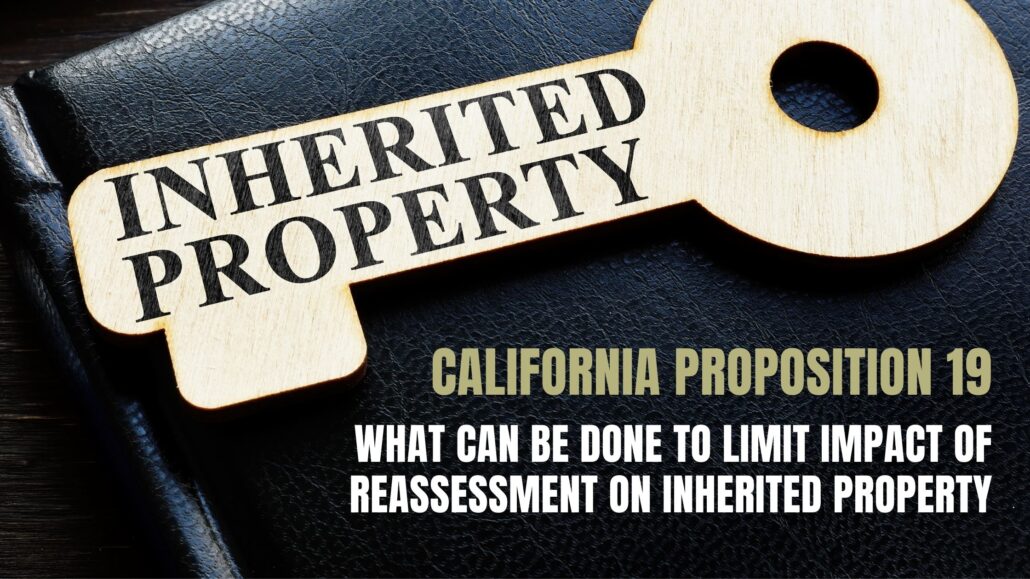
When placing a property into an irrevocable trust, it’s important to take property taxes into account. Before Proposition 19 was passed and became law in 2020, Proposition 13 had been in effect since 1978, which limited tax reassessments and made sure that beneficiaries would be able to receive a property without needing to spend an ample sum of money on property taxes. Proposition 19 places a limit on the parent-child tax exclusion. Despite this limit, it’s still possible to reduce the tax reassessment that occurs after death.
What is California’s Proposition 19?
Proposition 19 was passed by California voters in November 2020. This particular law is designed as a modification to Proposition 13, which mainly involves certain property transfers. When Proposition 13 was in place, the annual increases that could occur in property values were limited to 2% or less when ownership is transferred.
Over the years, additional modifications had been made to Proposition 13 that excluded different ownership transfers from tax reassessments. For instance Proposition 110 allowed severely disabled individuals to transfer the base annual value of their main residence to a secondary residence if specific conditions were met. Proposition 19 provides some benefits to transferred properties while also eliminating some benefits that had existed before.
How Prop 19 Affects Inherited Property
Proposition 19 affects inherited property in a number of different ways, all of which should be understood when planning an estate. Homeowners who are substantially disabled, victims of a declared disaster, or 55 or older will have additional options when transferring some of the property tax benefits that they currently have. These options include:
- It’s possible for an inter-county transfer to occur between any counties as opposed to two counties that are situated in the same ordinance.
- A homeowner may be able to purchase a property at a higher value while still retaining their tax benefits. The transfer doesn’t need to occur with a property that’s at the same or lower value.
- It’s possible for qualifying transfers to occur up to three times. For disaster victims, no limits are in place for how many times such a benefit can be used.
However, there are numerous changes with Proposition 19 that have placed additional limitations on inherited property. Children who directly inherit a property from their parents but don’t make the property their main residence will go through a tax reassessment. Heirs will also need to file and fully qualify for the Disabled Veterans’ Exemption or Homeowner’s Exemption within a year following the ownership transfer.
Parents and grandparents are no longer allowed to transfer as much as $1 million of additional property alongside their main residence. Because the fair market value for assessed values has been reset with Proposition 19, it’s possible for assessed values to increase considerably. Before now, assessed values were set at what they were in 1975, which means that the changes from then until now could result in a high increase.
For example, let’s say that a property had an assessed value of $50,000 in 1975. This could result in a property tax of $600 per year. If the property was reassessed to a market value of $750,000, the property taxes would increase to $9,000 per year. These changes can make transferring property to a child less feasible. However, there are still several options that can be used to limit the impact of reassessment on inherited property.
Remaining Options for Minimizing Tax Reassessment
If the person transferring the property is over the age of 55, it’s still possible to transfer the base value of the property in question. This exemption applies to replacement homes. If the person in question purchases a home for $2 million in 2020 but still has a home with an assessed value of $500,000 and a current value of $2.5 million, the base year value of the current residence can be transferred to the new property once the current residence has been sold.
There’s also a proportional transfer rule in place that you can take advantage of. Let’s say that three people formed an ownership partnership that resulted in each person having between 30-40% ownership. In the future, two of the owners could purchase the other owner’s share of the property without needing a reassessment. This benefit is available as long as less than 50% ownership is transferred.
The third and final benefit that can be used with inherited property is available when two parents create an LLC. This LLC can be used to buy a home. Eventually, the two parents can bequeath their shares in the property to their children. Keep in mind that this exemption is only possible when the parents bequeath their shares of the property to two or more children. In this situation, none of the beneficiaries will have more than 50% ownership in the property, which means that a reassessment won’t occur.
While Proposition 19 has made some substantial changes to the act of transferring a property from one person to another, there are still some exemptions in place that effectively allow someone to bypass tax reassessments.
Disclaimer: The information provided on this website does not, and is not intended to constitute as legal or financial advice; instead, all information, content, and materials available on this site are for general informational purposes only. Additional facts, facts specific to your situation may affect information contained herein. Information on this website may not constitute the most up-to-date legal or other information. This website may contain links to other third-party websites. Such links are only for the convenience of the reader, user or browser; Nelson & Associates, CPA’s does not confirm the validity of the contents of the third-party sites.


